Spider-view: "Home Again, Home Again" (Spider-Man 2099, Part 4)
A fun fill-in issue tells an enjoyable, self-contained story, bolstered by an incredibly detailed fill-in artist
—by Nathan on September 10, 2025—
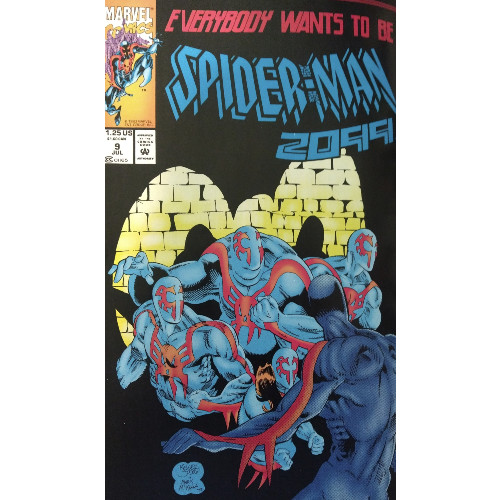
It's transition time again, as we jump over a hundred years from where we previously encountered Peter Parker and emerge once again in the grim future of one Miguel O'Hara.
We last left our UMF-clad hero desperately battling against self-proclaimed predator and lord of the skies, the Vulture, in the scuzzy underworld of "Downtown," an area literally underneath the shiny, high rise-festooned realm of Nueva York. That three-part tale by the late Peter David (man, it's disappointing to write that descriptor) and Rick Leonardi represents, for me, the high-water mark of the series. That's a huge compliment, as the other narratives I previously read are incredibly well-written and exciting. But that trilogy has always been a personal favorite, so I should say there's no use making comparisons. It's all great…it's just those three issues are the greatest.
As Spider-Man 2099 #9 opens, our hero has narrowly escaped death (and probably having his corpse eaten by the cannibalistic Vulture). Triumphantly defeating his winged foe, Miguel returns to the upper world…but what will he find waiting for him?
"Home Again, Home Again"
Writer: Peter David
Penciler: Kelley Jones
Inker: Mark McKenna
Colorist: Steve Buccellato
Letterer: Rick Parker
Issue: Spider-Man 2099 (vol. 1) #9
Publication Date: July 1993
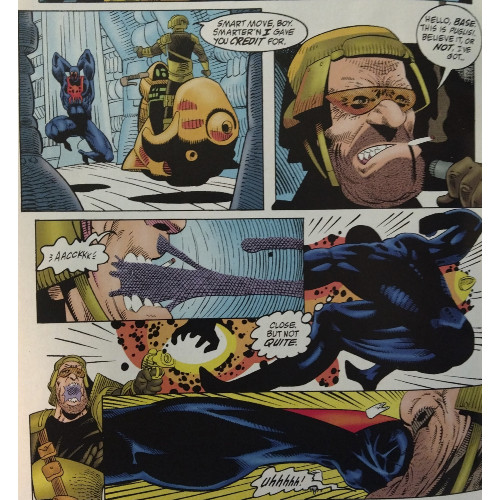
This story could serve as either an epilogue to the three-part Vulture conflict we just covered or a lead-in into the next single issue story we will discuss in another post. After thinking it over, I decided to let this issue stand on its own, partially because it tells a different type of story than SM 2099 #10 and partially because it feels separate enough from what’s come before (what with the change in artist) that I wanted to give it room to breathe, even if it’s a filler issue.
"Home Again, Home Again" sees Miguel returning to Nueva York, bursting forth in an energetic splash page designed beautifully by Kelley Jones. A handful of years ago, I read a run Jones and writer Doug Moench collaborated on for the Distinguished Competition on a top tier DC hero you may have heard of called "Batman." While I found several of the stories to be only mildly interesting, my greatest takeaway from the tales I collected and read was undoubtedly Jones' art. Jones strives for a slightly hyper-realistic style in the way he crafts his characters, with people looking somewhat like actual humans instead of 2D images splashed against a background, barring some exaggeration; Jones zooms in on faces, adding necessary wrinkles and often focusing on using eyebrows to have his characters emote. His humans have depth to them, and his monsters (Man-Bat, Killer Croc, etc.) are dark and terrifying. Settings like the streets of Gotham or Floridian swamps are typically grim, with eye-popping detail adding to an ambiance of disquiet.
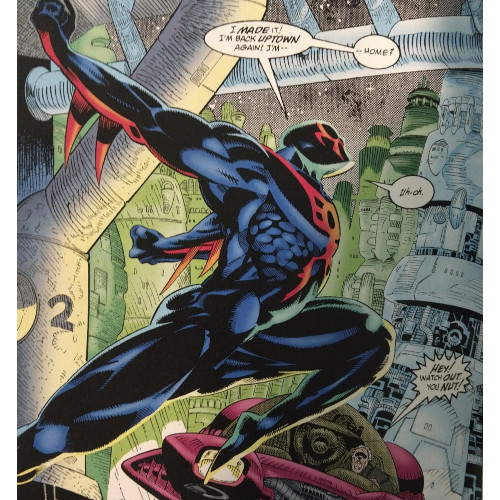
I wasn't sure, when I first read this issue years ago, how much I appreciated Jones' style. The realism reminded me of Alex Ross–not that the two artists' work necessarily looks the same, but that they strive for a more human feel in their books. The art in this issue, therefore, was initially jarring and felt out of place, especially considering the shift from Rick Leonardi, who is no less detailed yet maintains more of a "comic" quality. Over time, I've grown more comfortable with Jones, especially after watching his and Moench's version of Batman tear his way through the dark corners of Gotham City.
Spider-Man 2099 is a darker take on the Web-Head than mainstream Spidey comics, and though the Downtown arc may have been a better showcase for Jones' talent, the artist works well in this one-off issue. While I love Rick Leonardi’s take on this futuristic world, especially in how he creates eye-catching details and imbues each panel with a sense of newness and sci-fi wonder, Jones’ work gets to the heart of the dystopian world Miguel exists in. New York 2099 might not be as grim as Gotham City, but it’s still a troubled, broken place run by power-hungry individuals. Jones captures that grim situation well.

The bulk of the issue deals with Miguel’s attempts to get back home, a stop-and-go approach constantly interrupted because nothing can be easy when you go by the name "Spider-Man." If it's not immediately almost getting hit by a car, it's being caught "flatfooted" (as Miguel himself says) by a Public Eye officer or being drawn into a police chase once he disguises himself as an officer of the law. David dishes out conflict in the form of inconveniences which hinder Miguel's progress and makes the issue work far better than if a supervillain popped around a corner to battle Spider-Man. This is how you do a fill-in issue: creating an engaging form of conflict restricted to a single issue that can still tell us a bit about our central characters or provide even some slight momentum for background narratives.
Simultaneously, David manages to weave in some engaging world-building, constructing a few aspects of larger plots without feeling like his primary Spider-Man narrative is being interrupted. David had previously introduced "Thorites," followers of Thor who have come to see Miguel's Spider-Man as a harbinger of the famed Norse god. Miguel encounters a sect of these believers now mimicking him as "Spiderites," and it's a level of attention he does not approve of in the slightest (something I'll discuss a bit more in the next 2099 post). He just wants to get home, man, not deal with a grassroots religious organization who wear copies of his costume and try to climb walls with suction-cup fingers.
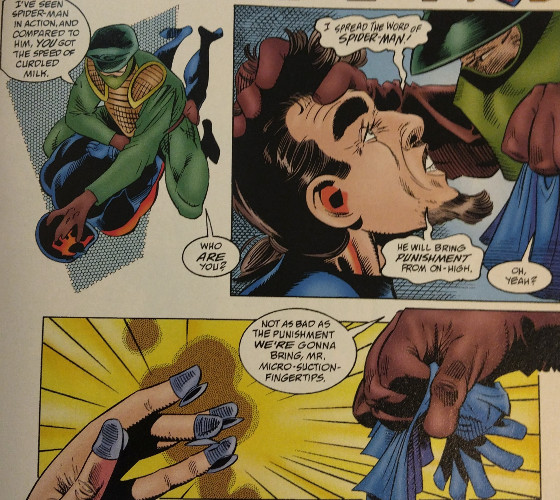
Elsewhere, David plays with subplots concerning Miguel and Gabriel's mother, Gabe himself, a disgraced former Public Eye sergeant, and Miguel's holographic assistant Lyla (yeah, really). David slips in these pieces well, adding to the overarching narrative by creating reasons to keep reading outside of Miguel's own struggles. His mother has a medical attack of some kind…what's going to happen to her? Gabe finds himself torn between his brother and Casey, the girl he loves…who also leads a band of Downtown revolutionaries! Former Sergeant Estavaz, fired from his position after knocking Miguel into Downtown, finds a new possible purpose to follow, drafted by a mysterious woman and brought to a town called Nightshade. I remember reading this issue, years ago, being highly intrigued by what would happen next. It's a feeling that was maintained through this most recent reading as well, as I enjoyed how masterfully David teases subplots with the promise of several unfolding narratives and engaging characters.
And all poor Miguel wants to do is get home. Yeesh.
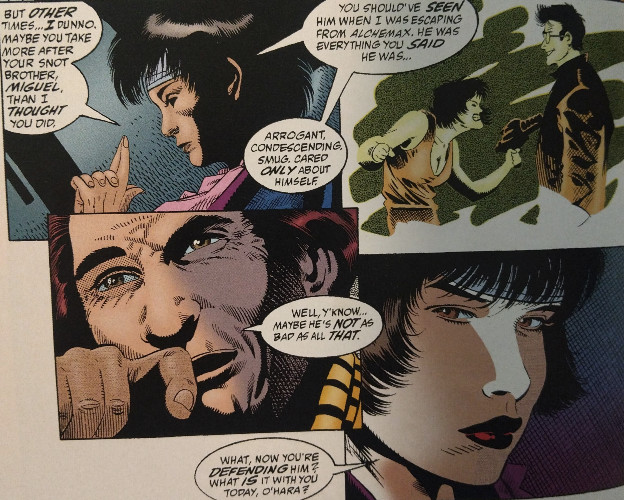
"Home Again, Home Again" cannot be considered an overly memorable or remarkable issue if you're looking for a continuation of the brilliant action David and Leonardi developed in the previous issues. Miguel’s misadventures in finding his way back home feel very Spidey-like, and the Nightshade element is an important nod to future developments, but the issue as a whole doesn’t stick out for the "big action fight crowd." The story takes a middle seat to the art, because Jones’ pencils cause individual scenes to be vivid and individual people to feel real and fully formed. The splash page is a gorgeous action shot of Miguel leaping to freedom, arms behind him as he lunges into the open air of upper New York. Poses like these make Jones' art feel lively and help me appreciate his art more than I did while reading his Batman material. I will admittedly always be partial to Leonardi's work, but the striking contrast between the two artists is notable, and nowhere else in the series so far does the world of New York 2099 look as bleak and dystopian as in Jones' hands.
I said "middle seat" above because the issue isn't sitting in the back of the bus while David and Jones copilot. The "Miguel just wants to get home" plot is reminiscent of an Amazing Spider-Man issue David wrote in the 80s about a somewhat similar premise that I may just have to re-read and review now. It's fun, with great bits of humor–a misguided youth who believes Spidey thinks the world of him, Miguel ruining a disguise because one of his talons pops out, and Spidey just so happening to disguise himself as a hypochondriac Public Eye officer. You've got great Peter David hallmarks here, with clever dialogue and fun jokes. But it's all the more engaging knowing Jones joins him in the endeavor, offering a glimpse of his Nueva York that makes me wish he had more opportunities to invest in this future world.